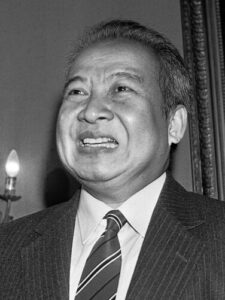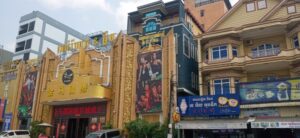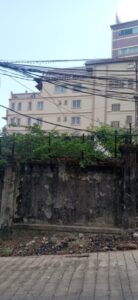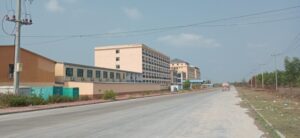by Emanuele Giordana from Sihanoukville (Cambodia)

Sihanoukville – The building stands in the middle of the city centre. It is surrounded by a high wall with barbed wire and an entrance door with guards and cameras. At first glance, it looks like any other building, although the security measures outside are unusual. On closer inspection, however, all the windows are barred. This would be common enough if the bars were to keep intruders out, and indeed some houses in Sihanoukville, the Cambodian port dedicated to Sihanouk, the historic ‘Red Monarch’, have bars on the first and second-floor windows. But here everything is barred up to the roof, not to prevent entry but… exit. Welcome to Sihanoukville, the queen of Southeast Asia’s scam towns. Where a horde of cybernetic slaves, under the inflexible orders of the Chinese mafia, organise a tried-and-tested system of online scams every day: from gambling to cryptocurrency investments that have only one goal. To empty the bank accounts of those who fall for it.

To understand why the Chinese mafia has chosen Sihanoukville, you have to take a step back. Recently, the Cambodian authorities reviewed the draft of the second phase of the plan to create a multifunctional special economic zone (SEZ) in the city. This project dates back to 2006 and has gone through several phases. It aims to transform the city into a major economic zone in Southeast Asia, with an advanced industrial zone for regional and global production chains using the latest technology and equipment. A Cambodian Shenzhen, inspired by the Chinese technological city par excellence, with its Institute of Urban Planning and Design. The Sihanoukville Zes is the largest in Cambodia, and development and money are on everyone’s mind, including the mafia. But the plan suffered a major setback in 2020 when Phnom Penh banned online gambling in the dozens of casinos that had sprung up in the city – an illegal practice, but not in Sihanoukville. The surprise move collapses the entire illegal and parallel gambling economy, with all its attendant prostitution, human trafficking and violence. But it is also a blow to urban development itself, whose construction boom was accompanied by licences for a hundred casinos. Covid did the rest, and the city’s economy has collapsed, leaving the skeletons of entire buildings under construction – developed with the idea that Sihanoukville would also become the largest casino in Southeast Asia – abandoned for the collapse of the weekend tours of thousands of Chinese green-table aficionados. These had boosted the city’s economy and promised lucrative construction investments until 2020. Illegal development goes hand in hand with clean development. With the Chinese – and a few clever Cambodians – acting as victims and executioners. Both beaten.

Now, however, Sihanoukville has come back to life and activities have resumed. Many of the skeletons that made the town look like a bombed-out city in 2020 have either been completed or are in the process of being rebuilt. It is not a very high percentage, but a good third of the abandoned buildings seem to have come back to life. Land and property prices, which went through the roof during the casino era, have come down, allowing for new investment. Clean and otherwise. It is not difficult to notice the peculiarity of several buildings that all have the same characteristic: windows and doors covered with iron bars. Tools to prevent people from getting out.
These buildings are surrounded by high walls or corrugated metal partitions that block the view of the lower floors. To reach them, you have to negotiate narrow streets that are mostly blind. At the entrance to the buildings, a guarded door – sometimes preceded by an iron bar that acts as a checkpoint – shuts out the undesirables. They are not just ‘gatekeepers’. Almost all of them wear black uniforms and have unfriendly faces. They may be armed. Cameras appear on the corners. This is the second life the Chinese mafia has chosen for Sihanoukville. Far beyond the casinos and far beyond the mirage of Shenzhen: from gambling queen to ‘Scam City’, where an army of computer and telephone slaves expertly defraud thousands of people every day.
According to three researchers who have been studying Scam Cities for years – Ivan Franceschini, Ling Li and Mark Bo – they represent a new manifestation of predatory capitalism’: compound capitalism. These buildings are, in fact, veritable centres (compounds) where an army of slaves work online on multiple mobile phones for an average of 12-14 hours a day, devising telephone scams aimed at plundering the bank accounts of the unfortunate victims who respond to an initial message that arrives on Wathsapp, Instagram or other platforms. Usually from an attractive young Asian woman.

One of these compounds, pictured many times, is right in the city centre: in Mittapheap, district 1801, one kilometre from the city’s new port, next to the Sihanoukville Port Special Economic Zone (Spsez). The police shut it down after one of their rare clean-up operations, largely under pressure from China. But the army of fraudsters – often warned in time – is moved elsewhere before the raid. And not far from there, another building that has all the earmarks of a scam compound is going about its daily business. Undisturbed. You can tell because clothes are hanging out to dry behind the grates facing the street. It is not the only one. If you start paying attention, you will come across several of them along the city’s arteries, from north to south, from east to west. Everywhere the pattern is repeated: boundary walls, barbed wire, barred doors and windows, hanging laundry, guards. In the sunlight.
Towards Otres, the beach area, there is one of the most famous, called K99. It is unprotected by other buildings and stands alone on a closed road where there are at most a few hawkers. Surrounded by walls, it has the feel of a barracks. Everyone knows what is happening to K99, but its owners don’t seem to care. They don’t hide.
Franceschini and his colleagues have collected dozens of testimonies, they reconstructed the hierarchy in the camps, the trafficking, the torture, and even how much it costs the prisoners to earn their wages: they have to pay for everything from food to beds. If they do not, they are beaten. According to the United Nations, this army has more than 200,000 slaves in Southeast Asia, half of them in Cambodia. According to John M. Griffin and Kevin Mei of the American University of Austin, there are some 75 billion dollars in suspicious deposit accounts. Money was made mainly from the scams of this new form of slavery between Cambodia and Myanmar, but also in Laos.
On the cover photo, Sihanoukville, the resumption of work
All other photos are the property of the author and Atlas of Wars and may only be used with attribution and a link to the article from which they were taken
























